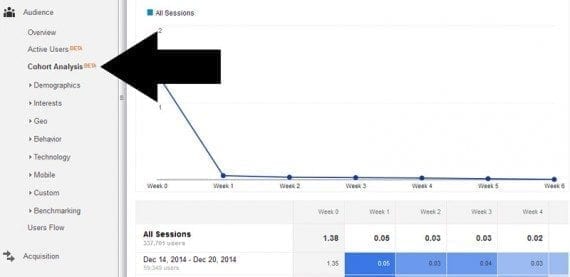Google has added a basic cohort analysis report to its popular Analytics suite.A cohort is a group of people or subjects who all share some time-bound
event, characteristic, or experience. For example, shoppers who visit an
ecommerce site for the first time on March 27, 2015 could be said to
be a cohort since they have a shared characteristic — they visited for
the first time — and the experience was during the same time period, March 27, 2015.

The Analytics’ cohort report can be configured around cohort type, cohort size, metric, and date range.
First, cohort analysis, like all analysis, should begin with a question. Why are sales rising or falling? What is the best time of the month to launch a new ad? How many days before a holiday like Valentine’s Day should we send an email to get the most sales? What is the long-term value of customers who come from our blog?
This initial question should also help define what you will measure in the cohort analysis.
Next, you’ll need to identify the event or characteristic that defines the cohort you want to measure. For now, in Google Analytics, it will have to be acquisition date. If acquisition date won’t do, you’ll need a different way to collection information.A cohort analysis can help identify and clarify business trends.
Cohort Analysis
Cohort analysis is, perhaps, most useful when two or more cohorts are
compared. This comparison lets marketers and analysts see the
relationship between the two cohorts over time.

The Analytics’ cohort report can be configured around cohort type, cohort size, metric, and date range.
- Cohort type. At the time of writing, the only available cohort type was acquisition date, thus one could look at how folks who visited the site on a particular date behaved over time.
- Cohort size. This report attribute may be set to day, week, or monthIt may be the case that if Google added additional cohort types, it would also expand the list of available cohort sizes to include other sorts of dimensions.
- Metric. This is simply the thing one wants to measure. Presently, metrics include conversions per user, page views per user, sessions per user, user retention, goal completion, conversion, and more.
- Date range. The relative date range for the data to be displayed.
First, cohort analysis, like all analysis, should begin with a question. Why are sales rising or falling? What is the best time of the month to launch a new ad? How many days before a holiday like Valentine’s Day should we send an email to get the most sales? What is the long-term value of customers who come from our blog?
This initial question should also help define what you will measure in the cohort analysis.
Next, you’ll need to identify the event or characteristic that defines the cohort you want to measure. For now, in Google Analytics, it will have to be acquisition date. If acquisition date won’t do, you’ll need a different way to collection information.A cohort analysis can help identify and clarify business trends.
No comments:
Post a Comment